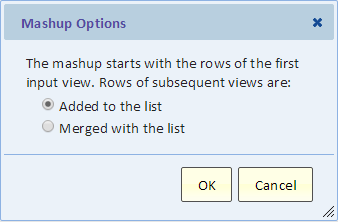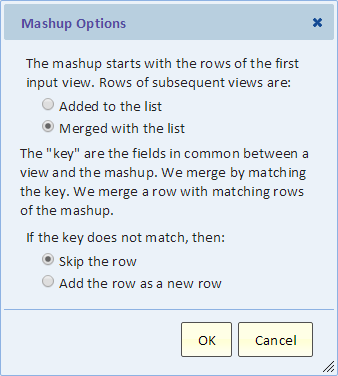List Mashup
Introduction
A list mashup is a Mashup View of two or more list views.
When creating a mashup of lists, columns with the same heading are merged into a single column.
By default, rows are not merged. They are simply added together. This is useful for combining two lists into a single list. The single list will have all the rows from all the inputs sorted together. This type of mashup is always used when drilling through to details from a pivot or chart. In that case, we want to see a list of all the rows that contributed to the category grouping on which the drill-through action is performed.
Changing the Type of a List Mashup
To change the type of a list mashup, use the Mashup Options button in the buttons shown below the breadcrumbs when the mashup is displayed
The Mashup Options dialog displays the mashup type and allows you to change it. By default, rows are added together and not merged.
If you'd like to merge together rows of different input views, select the second option "Merged with the list".
Merging Rows
To understand what we mean exactly when we say "merging rows", consider the following steps:
- We start with the set of rows of the first input view. This forms the current list. Initially, the list has the set of columns of the first input views.
- For each subsequent input view, we match rows against the list. Wherever a row matches a row in the list, we merge the row into the existing row.
- If a row does not match any of the rows in the list, we have two options: we can add it as a new row, or skip it. This is defined in the Mashup Options Dialog as depicted below.
We match rows by their common fields. The common fields are the fields that have the same column heading (label). The dialog refers to the common fields as the "key".
The list starts off with the columns of the first input view and gains more columns as subsequent input views are added to the mashup.
When we match a row against the list, it could match multiple rows in the list. In that case, we merge it with all the matching rows.
Normally, we want the "key" to uniquely identify the row in the input view being added to the mashup. If that's not the case, the last matching row wins. For example, suppose the key consists of two columns "First Name" and "Last Name". Suppose the list has John and Smith and we merge it with an email list that has two email addresses for John Smith. When we merge the rows, the email for John Smith will be the second of the two email addresses. The first email for John Smith will be discarded (overwritten by the second).

